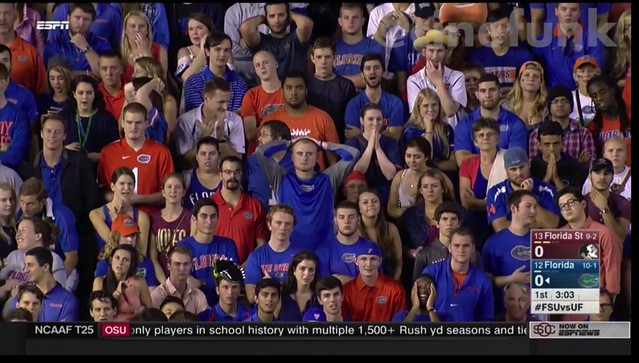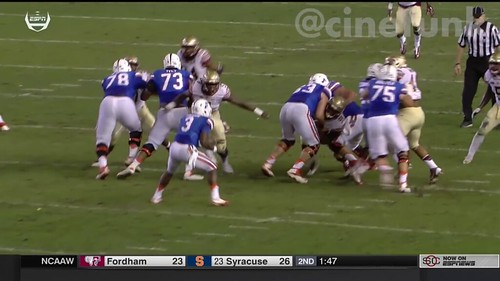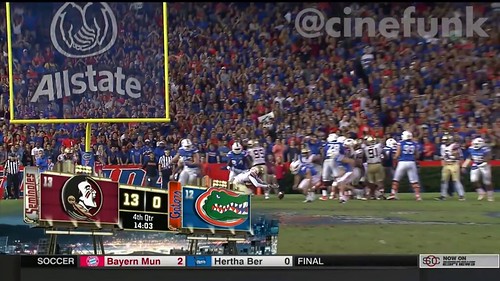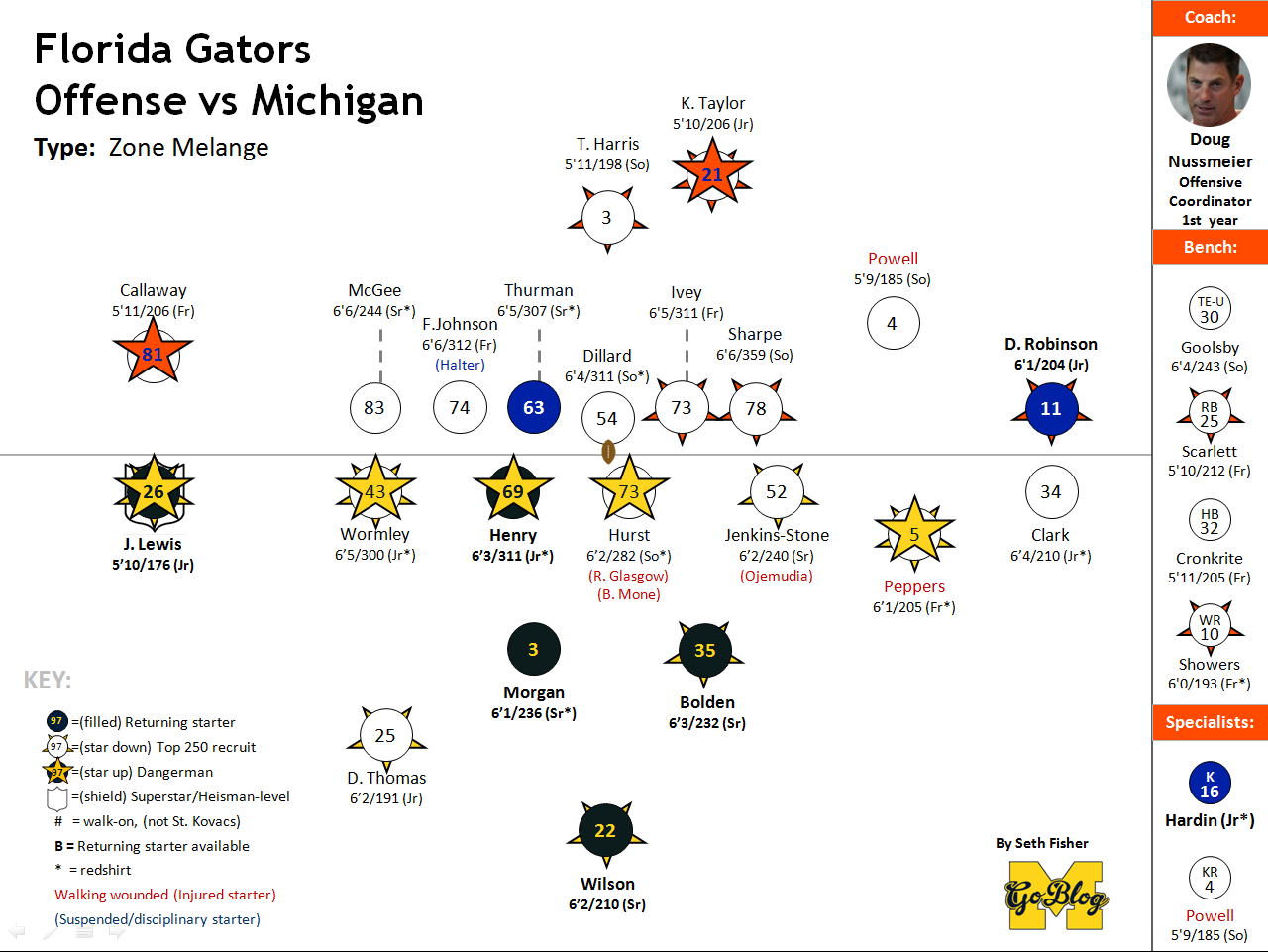Fee Fi Foe Film: Florida Offense


It's tied in the first quarter, but these people have seen some things.
I thought I was past this. Then came the bowl matchup.

Florida's zone melange mustered only 3.3 yards per play and no points in their 27-2 loss to Florida State to end the regular season. Since UF has undergone several personnel changes, I wanted to choose a late-season game against a team with a pulse, and the other option that fit the criteria was Alabama. There was no good choice.
Anyway, Florida's offense is bad, not fun to watch, and reminiscent of a team I've attempted to drink out of existence.
Personnel. Seth's diagram [click to embiggen]:
An inexperienced group got even worse in that regard when right tackle Mason Halter was ruled ineligible for the bowl game, opening up the potential for as many as three true freshmen to start on the line; in addition to year-long starter Marcus Ivey and Halter's replacement, Fred Johnson, Tyler Jordan could slide into the lineup at right guard—where he started the last two games—and bump senior Trip Thurman to center.
Spread, Pro-Style, or Hybrid? Spread, in that Florida took almost every snap from the gun.
Basketball on Grass or MANBALL? Florida is about as zone-heavy as it gets. They run a ton of inside zone, often with the slot receiver going in fly sweep motion, though they rarely utilized that option. They'll mix in the occasional power but for the most part it's inside zone and some zone stretch.
Hurry it up or grind it out? Florida is 114th in adjusted pace, which should surprise nobody who watched Michigan last year.
[Hit THE JUMP for the rest of the breakdown.]
Quarterback Dilithium Level (Scale: 1 [Navarre] to 10 [Denard]): Treon Harris is a quick and elusive runner who's averaged 6.7 yards per non-sack carry this season, though he's struggled to produce against better defenses. That might be due to scheme. Against FSU, Harris' only designed runs were a couple QB draws that went nowhere; at no point did Nussmeier try to keep the defense honest with a zone read even though the running game relied on inside zone. Yes, that looked familiar.
Harris can be dangerous as a scrambler when he's not running himself into trouble:
He gets an 8.
Dangerman: The offense rides or dies with Kelvin Taylor, the son of former UF and Jacksonville Jaguars standout Fred Taylor. The younger Taylor is yet another opposing back I now covet after watching him on tape. He's a patient runner who reads the play well and is the proverbial one-cut, plant-and-go runner you need to effectively run in a zone scheme.
Taylor's stats aren't impressive but he's dealing with a mess of a line and defenses that can safely key on him; given the context, he manages well, and when he gets to the second level he's tough to haul down without leaking extra yards. He consistently popped through the hole in this game, finishing with 136 yards on 24 carries; no other UF back toted the rock more than once.
In the passing game, freshman Antonio Callaway is one to watch. While Florida couldn't get anything going downfield in this game—longest completion: 15 yards—Callaway had a couple nice grabs over the middle, and he's a threat to take the top off the defense; he averages 20.1 YPC, albeit on a 44% catch rate. If UF wants to test Michigan deep they'll go his way; given Michigan's coverage and Harris' erratic arm, this isn't a matchup that's too concerning.
Zook Factor: Game theory stuff was fine in this game. If you want to take into account Nussmeier's seeming refusal to expand his playbook to utilize his mobile quarterback's legs when the passing game is a disaster, I won't stop you.
HenneChart: Florida's passing game is a confluence of erratic quarterback play, bad blocking, and a receiving corps that struggles to get open. As you'd expect, the results aren't pretty:
| Opponent | DO | CA | MA | IN | BR | TA | BA | PR | SCR | DSR |
|---|---|---|---|---|---|---|---|---|---|---|
| Florida State | 1 | 14 (5) | -- | 5x | 3 | 5 | 5 | 6 | 2 | 40% |
We'll start with the primary issue: Treon Harris didn't look good. He has trouble hitting his targets, even when they've managed to Jeremy Gallon their way into acres of open space:
There were a couple other throws I had a hard time categorizing because it was tough to figure out if Harris made a bad read, missed his target, or tried to throw the ball away. It's not good when those things are easily confused. The farther down the field the ball traveled, the less likely it was to be catchable; Harris mostly stuck to quick slants and dumpoffs to the flat unless the situation called for more.
Harris has a habit of holding onto the ball forever before trying to make a desperate play after the cavalry has arrived. The offensive line isn't without fault—they're not good—but the amount of time Harris spends in the pocket exascerbates their issues. This stat from PFF came as no surprise after watching this game:
Highest throwaway rate: Treon Harris (Florida Gators), 12.1 percent
With 26 throwaways from 214 pass attempts, 12.1 percent of all passes Treon Harris attempted were throwaways — one other QB had a rate above 10 percent. That’s in stark contrast to the man he replaced, Will Grier. Grier had four throwaways from 163 attempts, so 2.5 percent of his passes were thrown away.
There were several plays in which Harris had little choice but to chuck the ball out of bounds; there were a few more in which he left himself no choice after waiting too long in the pocket.
Harris also had five—five!—passes batted down at the line, and those were mostly his fault. He's 5'11", stares down receivers, and releases the ball low. He had a hard time throwing the ball over the middle without hitting a DT's outstretched arm (or, in one case, a DT's armpit).
OVERVIEW
Florida operates almost exclusively out of the shotgun, throwing in a few snaps from the pistol and going under center only for short-yardage situations.
| Formations | Run | Pass | PA |
|---|---|---|---|
| Gun | 23 | 36 | 3 |
| I-Form | -- | -- | -- |
| Ace | -- | -- | -- |
| Pistol | 2 | -- | 2 |
| Heavy | 2 | -- | -- |
The offense tried to stay balanced, but their trouble staying on schedule led to a lot of third-down throws:
| Down | Run | Pass | PA |
|---|---|---|---|
| 1st | 10 | 12 | 4 |
| 2nd | 12 | 13 | -- |
| 3rd | 5 | 12 | 1 |
In related news, Florida went 5-for-17 on third downs. (I ceased charting when FSU went up 20-2 in the fourth quarter.)
I've covered the quarterback play extensively enough above; it's bad and handcuffs the entire offense. Not all of the offenses's woes can be blamed on Harris, though. It's hard to produce as a passer when the opponent can play Cover 1 and blanket receivers like this:

FSU's secondary is very good, but so is Michigan's, and UF's receivers got little separation all afternoon. They were missing possession receiver Demarcus Robinson in this game, but I have a hard time believing a guy averaging 6.9 yards per target is going to make a huge impact. Callaway couldn't get over the top of the defense, slot bug Brandon Powell only caught dumpoffs, and the only guy to consistently get open was TE/H-back Jake McGee, whose routes rarely took him past the sticks.
Then there's the O-line, which allowed pressure on just about anything that wasn't a straight-up four-man rush. This is a screencap from a designed QB draw; FSU stunted and freshman guard Martez Ivey (#73) failed to switch his assignment, allowing the DE into the backfield untouched:

That wasn't the only time UF had issues with stunts and twists; I noted two other missed pickups that led to sacks. Blitz recognition was a problem all around. On one play I should've clipped, FSU telegraphed a corner blitz from the back side; Harris never saw it, the line made no adjustments, and when the blitzer hit home not a single receiver was even looking back for the ball. The combination of inexperience on the O-line and at quarterback is a serious issue and one that Michigan stands to exploit.
They also weren't great straight-up. I have a note about RT #75 being ragdolled to the ground by a DE for a sack; #75 is now ineligible for the bowl game, leaving the true freshman who played behind him—or one of two other true frosh who didn't see the field this year—to man the edge against Chris Wormley. It's safe to say that matchup favors the Wolverines.
Florida even had trouble with two center-QB exchanges. Trip Thurman manned the center spot for UF's last two games; in this one he turfed two snaps and both resulted in TFLs. Cameron Dillard, who started the first 11 games, is listed atop the depth chart at center in the game notes, though those notes still include the now-ineligible players.
As for their run-blocking, they did a decent job of holding down the first level, but beyond that it was up to Taylor to create extra yardage. Taylor's runs tended to either burst into the secondary, where a safety would clean up, or meet unblocked linebackers a couple yards down the field.
I'll leave you with the sea of surrender cobras ESPN captured when UF's best non-garbage time drive of the day—a 16-play, 56-yard slog—ended with a blocked field goal.

It'll be up to Florida's defense to keep them in this game; as you'll see tomorrow, that side of the ball is up to the task.
December 29th, 2015 at 3:11 PM ^
Sent from MGoBlog HD for iPhone & iPad
December 29th, 2015 at 3:22 PM ^
I googled "zone melange mustered" and discovered some wonderful deals on women's ethnic wear.
December 29th, 2015 at 3:31 PM ^
Michigan never has trouble stopping fast, athletic running QBs.
- What, never?
Well, hardly ever.
December 29th, 2015 at 8:01 PM ^
.... would you find a pinafore reference in the comments section of an opponent scouting post. It’s surely to your credit
December 30th, 2015 at 12:43 AM ^
I remain a Michigan Man.
December 29th, 2015 at 3:39 PM ^
but how did you manage so many words about the Florida offense? Not gonna lie, I'm impressed. A true wordsmith you are
December 29th, 2015 at 3:42 PM ^
Waste of time really. I would have gone with a gif of a couple a tortoises attempting to hump.
December 29th, 2015 at 8:45 PM ^
that now.
December 29th, 2015 at 4:13 PM ^
At least some fans question Harris' option acumen. Florida's 2014 OC, Kurt Roper, incorporated zone read while at Duke and sprinkled it in for Jeff Driskel. But he rarely (if ever?) let Harris read an unblocked player in his six 2014 starts. Nussmeier also let Will Grier run a few zone reads early in the season, so it's theoretically in the Florida playbook. Make of that what you will.
This would be a highly entertaining game if Florida had its passing game from the first half of the season, but as it is, it shouldn't be much trouble for even a somewhat motivated Michigan team.
December 29th, 2015 at 4:46 PM ^
gameplan? I would think Nuss and McElwain would be dumb not to try to do that.
December 29th, 2015 at 5:07 PM ^
December 30th, 2015 at 10:00 AM ^
...but if you got a QB who is reasonably capable of running and a RB who reads holes well, you might as well try some read option. Especially if your passing game isn't very good. What else do they expect to be able to do? I'd expect to see SOME of it early and then, depending on how it goes, keep using it or ditch it.
December 29th, 2015 at 5:29 PM ^
there has been so little written about our upcoming bowl game? It certainly explains why we are favored, although I would have thought we would be favored by more than we are, because it sounds like we are better on both sides of the ball.
December 30th, 2015 at 12:15 AM ^
probably better than ours has been the second half of the season (sans Glasgow) and almost certainly better by a significant margin if Peppers is out. That's how you get a four point spread. And the fact the game is in FL.
December 29th, 2015 at 6:03 PM ^
I've posted this before but I'll leave it here. Coach Jim McElwain appeared on the SEC Film Room earlier this year. He broke down around 15 total plays for me but here are a few. If you want more I'll get that posted.
http://www.secsports.com/video/14164948/florida-jim-mcelwain-joins-sec-film-room
December 29th, 2015 at 6:29 PM ^
Me thinks there is another FFFF shoe about to drop that will explain what we have to worry about in this match-up ...
December 29th, 2015 at 8:02 PM ^
Sent from MGoBlog HD for iPhone & iPad
December 29th, 2015 at 10:34 PM ^
I'm just happy for sweet, sweet content...
December 30th, 2015 at 3:07 AM ^
low scoring affair. Both defenses are much better than the opposing offenses.
Florida also suspended backup RB Scarlett. But Nuss would probably play Taylor the whole game anyway. He runs a one-back offense dominated by the starter.
However, expect Nuss to finally open up the playbook and let Harris run a lot more. Dual threat QBs do a lot better when the OC lets them run more. Gardner referred to Borges "finally opening up the playbook and let him run" in the 2013 OSU game, and played very well. And of course we've also seen the opposite when an OC tries to restrict his dual threat QB from running (Borges-Denard at Iowa and ND).
December 30th, 2015 at 7:31 AM ^
Florida has a bad, depleted offense and a great defense. Michigan has a middling offense and a great but depleted defense. Logically, Florida will struggle to move the ball and they have what it takes to shut down Michigan's offense.
So the final score will be 52-47 because football.
December 30th, 2015 at 8:59 AM ^
December 30th, 2015 at 9:48 AM ^
. . . but yes.
December 31st, 2015 at 12:55 AM ^
December 30th, 2015 at 10:21 AM ^
Borges>Nuss
December 30th, 2015 at 12:08 PM ^
Borges can't develop for crap but he can draw up some fiendish plays. The problem is that he can't keep his bag of tricks full because he uses it when there's something in there, not when he needs it. Oh, and that he can't develop for crap.
Nuss is not creative; he tries to build an offense around IZ. He doesn't have answers if it doesn't work, but IZ takes time to learn anyway, so he'll run it until the offense can execute it. His scheme won't torch a defense (unless he's coaching Alabama), especially when he needs to, but his goal is a "boring" offense that can get 4-5 yards whenever it wants, to the extent that that threat opens up other plays. This takes a lot of time and patience.
Nuss is in his first year at Florida, so yeah, the advantage goes to "win now" Borges. Give both OCs three years and they're much closer to parity.
December 30th, 2015 at 10:58 AM ^


Comments